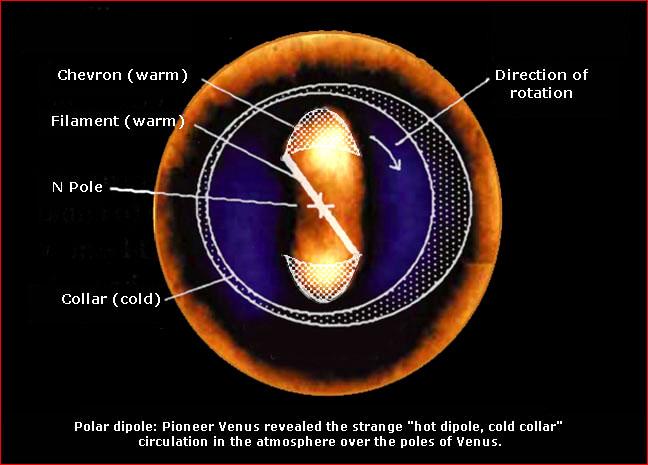
home •
about •
essential guide •
picture of the day •
thunderblogs •
news •
multimedia •
predictions •
products •
get involved •
contact

Credit: F. W. Taylor. Composite image: W. Thornhill.
pic of the day
archive
subject index
abstract
archive
Links:
Society for
Interdisciplinary
Studies

Thunderbolts of the Gods is a
108 page 8-1/2 x 11 full color monograph based on the life work of the two
authors--a revolutionary synthesis of comparative mythology and the
newly-discovered "Electric Universe".

The Monograph includes
an hour-long DVD introducing various aspects of the Electric
Universe explained by members of the Thunderbolts Group.
Dec 07, 2005
Electric Dipole of Venus
Late pertinent information: The polar caps of Earth have now been shown to be filled with supersonic outflows of plasma. Is this a standard feature of planets?
The diagram above depicts the main features of an extraordinary phenomenon discovered by the Pioneer Venus Orbiter in December 1978. Mission scientists called it a “giant vortex of surprisingly complex structure and behavior located in the middle atmosphere at the north pole of the planet.” They assumed that a similar feature occurred at the south pole as well.*
This polar “vortex” on Venus is the hottest spot in the planet’s upper atmosphere. The diameter of the “collar” around the vortex is about 5000 km and the temperature contrast between the hottest part of the chevron-shaped dipoles and the coldest part of the collar is about 45 K. The configuration was not expected, and it remains an anomaly.
Electric theorists, however, say that Venus is highly active electrically due to its unique origin and comet-like past. They will tell you that astronomers and astrophysicists, having received no training in the behavior of electric discharges, fail to perceive such electrical phenomena, so they are continually straining to explain electricity’s unexpected effects.
To a plasma cosmologist, the polar vortex is a cross-sectional view of a cosmic electric current. Within the solar system, as in every observed region of space, electric currents flow over vast distances by means of filaments of plasma that tend to organize themselves into “twisted pairs.” A common name for this “doubleness” in current-conducting plasmas is “Birkeland currents”. All the features shown above suggest that the two hot spots are the “footprints” of cosmic Birkeland currents. The "giant vortex" and its "surprisingly complex structure and behavior" are the energetic effect of twin currents flowing into the planet’s atmosphere at the poles. In fact, the Venusian dipole shows both the configuration and the motion of Birkeland current pairs in plasma discharge experiments and in super-computer simulations, including the surrounding spiral vortex.
The polar dipole exhibits an enhanced infrared emission, a predictable effect of the dissipation of electrical energy in the upper atmosphere of Venus. It has a variable rotation rate, and the position of its axis of rotation with respect to that of the planet varies as well. It was observed to move 500 km from the Venusian pole in less than a day and return just as quickly. These movements find a ready explanation in the variable nature of the electrical input to Venus via the Sun, and the snaking about of the Birkeland currents—again, a predictable feature of electrical input.
Of particular interest are the linear filaments sometimes seen connecting the opposite sides of the hot spots. Taylor writes: “It is virtually impossible, even with complete license, to begin to speculate in any detail as to what mechanism could give rise to such a curious effect.” But here too the “curious effect” is no surprise to the cosmic electricians. As observed by plasma physicist Anthony Peratt, in simulations of two interacting Birkeland current filaments plasma becomes trapped in the elliptical core between them and produces precisely this effect. (See Physics of the Plasma Universe, page 120.)
It should be noted that Peratt’s simulations were done before the discovery of the Venusian dipole and were offered as an explanation of the electrical forces that produce spiral galaxies, the grandest cosmic plasma discharge phenomena in the universe. But the enormous scalability of plasma phenomena demands comparisons of this sort. The currents that form the Venusian polar dipole exhibit the same features apparent in the formation of a spiral galaxy from the interaction of two intergalactic current streams. The fact that a filamentary connection between two current “hot spots” occurs in laboratory discharge experiments, in computer simulations, on the planet Venus, and in galaxy formation suggests that a more unified picture of the universe is now possible.
This model allows us to predict that the “hot spot” at Saturn’s south pole will exhibit features similar to those found in the Venusian dipole when examined more closely by Cassini. Also, the north pole of Saturn may be expected to exhibit a similar effect. See Saturn's Strange Hot Spot Explained. [ http://www.holoscience.com/news.php?article=1xz2g6tn ]
* F. W. Taylor, “The Venusian Polar Dipole,” Middle Atmosphere of Venus, Akademie-Verlag Berlin, 1990, pp. 93-7. See also: www.pparc.ac.uk/frontiers/pdf/19F1.pdf
Professor F. W. Taylor is Halley Professor of Physics at Oxford University.
** Anthony L. Peratt, "Physics of the Plasma Universe," Springer-Verlag, 1991.
Contributed by Wallace Thornhill.
EXECUTIVE EDITORS:
David Talbott, Wallace Thornhill
MANAGING EDITOR: Amy Acheson
CONTRIBUTING EDITORS: Mel Acheson, Michael Armstrong, Dwardu Cardona,
Ev Cochrane, C.J. Ransom, Don Scott, Rens van der Sluijs, Ian Tresman
WEBMASTER: Michael Armstrong
Copyright 2005: thunderbolts.info